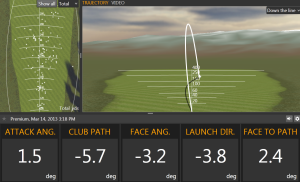The shot every Scottsdale golfer wants to hit
Learn how to hit the shot every Scottsdale golfer wants to consistently hit
By Scott Sackett
A perfect fade is a shot every player wants to consistently be able to hit. With the following knowledge and help from Trackman, you will now have an understanding of how to pull it off.
First, you’ll need to grasp the importance and relationship of clubface and path. In the image, the number with a red circle represents where the clubface is pointing at impact and the number with the blue circle illustrates the path of the golf club through impact (measured in degrees).
With an iron, the direction the clubface is pointing at impact is responsible for 75 percent of where the ball starts, and with a driver or fairway wood the clubface dictates 85 percent of the ball’s starting direction. Thus, it’s fair to say if you want to hit a fade where the ball starts left of your target, the clubface actually needs to be closed at impact. A negative face angle of -3.2, as illustrated by the number inside the red circle, will more than likely give you a ball which starts left of target (just as a positive face angle or open clubface will more than likely give you a ball which starts right of target). A negative number represents the movement of the golf club, orientation of the face angle at impact or starting direction of the golf ball going to the left. A positive would represent all of the same, except to the right.
Club path, the blue circle (not clubface), is responsible for the curvature of the golf ball. In order to hit a shot which starts left and curves right back to target, the club path of the golf club needs to be moving farther to the left than the clubface is pointing at impact (notice a club path of -5.7 is greater than a -3.2 closed clubface). In this example, the club path is -5.7 degrees to the left and you have a face angle of -3.2 degree to the left; giving us a club path which is pointing farther to the left than the clubface. The yellow circle in the image above is face to path, and this simple calculation tells us which way the ball will curve (a negative face to path will curve the ball left, and a positive face to path will curve it right). A -3.2 degree face angle minus a path of -5.7 degrees equals a face to path of 2.4 degrees, giving us the resulting ball flight (white line) which starts 3.8 degrees left of target (launch direction) and curves right.
This next part is the key distinction to make: the clubface is closed to the target line but open to the club path. For a right-handed player, a clubface which is open to the club path (as in this example and explained by a positive face to path number) will move left to right and one which is closed to the club path will move right to left (the opposite would hold true for a left-handed player). This explanation is assuming center contact. Also, both face and path are measured in relation to the target line. Face to path is derived by subtracting face and path (-3.2- -5.7=2.4)
So, next time you find yourself wanting to hit a fade starting left, remember this: For a ball to start left of target, the clubface needs to be closed to the target line and the club path (movement of the golf club through impact) needs to be moving farther to the left than where the clubface is pointing.
For more on this, visit the Trackman page on my website at scottsackett.com/trackman.
Related posts
Leave a Comment
You must be logged in to post a comment.







